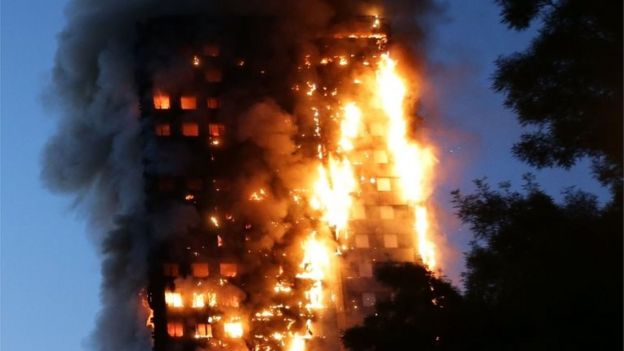Brutalism
The unfortunate people who had to live in Grenfell Tower have been raising safety concerns for years.
The residents of Grenfell Tower had reportedly raised fire safety concerns for several years before the blaze that engulfed the block of flats in west London on Wednesday, according to a community action group.
The claim comes as London Fire Brigade said there had been a “number of fatalities” at the tower block.
Grenfell Tower in north Kensington was completed in 1974 in the brutalist style of the era, comprising 120 flats over 24 storeys.
Ah yes, the “brutalist” style – aka as cheap and unadorned and brutally ugly as possible. Calling it “brutalist” makes it sound artistic, I suppose. What it really is is a giant “fuck you” to people who aren’t rich.
The company that did the renovations last year presumably didn’t actually soak the whole building in lighter fluid, so what I want to know is what kind of testing was ever done on the materials? How could a building go up like a torch that way?

Getty Images

FWIW, Brualism comes from Béton brut, French for raw concrete. It’s not my favorite, but I think there are a few examples of it being done well. Which isn’t to say calling in a cheap ugly building “Brutalist” wasn’t a useful dodge, for a while at least.
I could be wrong, but I’m not aware of any safety issues inherent in the Brutalist style (which is mostly about the exterior AFAIK. It’s the lack of stuff that’s mostly hidden, like fire stops and sprinklers, that can be really deadly. I don’t know of any architectural style that’s safe when those things are neglected.
No, I didn’t mean to imply the style had anything to do with the torch properties, that was just an aside.
To be uncharacteristically fair to Brutalism, I’m writing this from the Barbican, a surprisingly pleasant if not particularly friendly space. And this time last week I’d have been writing from the National Theatre.
It’s the kind of thing you’d expect to happen somewhere in the less developed, less health-and-safety conscious world. But it’s here, in Britain (where, apparently, health and safety has been running mad for several years…)
It shouldn’t have happened and I honestly believe it wouldn’t in a world where our governing body were a) competent and b) capable of judging things by standards wider than just profit margin.
Over the last year I have become increasingly ashamed of my country.
Hmm. The National Theatre is good on the inside, but it’s not much of an adornment of the South Bank.
I am no particular fan of brutalism and certainly not a fan of architects who value their artistic statements higher than the quality of life of the end users of their buildings, but it would be fair to say that brutalism was at least meant to be an artistic statement instead of an insult directed at the poor. As already discussed above, very prestigious buildings were designed following that school of thought.
Growing up in London I always associated Brutalism with civic buildings: schools, libraries, museums, hospitals and social housing. The cheaper, pre-cast ‘systems built’, towers had quality issues from the start but were welcome affordable/social housing at the time – now scandalously under maintained or sold off by the Tories for cheap political gains. I find it sickening that the knee-jerk reaction of cladding over concrete ‘monstrosities’, reminders of when public money was spent on new social housing, could have lead to so many deaths
I hadn’t realised until this summer (I’m now working regularly in Southbank) how pleasant the National Theatre’s terraces are. If I had to pick one building in which this style actually does seem to work, it would be this one. @Sorbus thanks for the point that the ‘house style’ of the postwar UK government would now connote civic investment; I hadn’t thought of that but it makes perfect sense.
For those of you back home, here’s where I had my first architecture training:
https://upload.wikimedia.org/wikipedia/commons/5/5c/Wurster_Hall_SW.jpg
Unlike the NT this building has no redeeming value whatsoever, except the lovely views of the campus (unmarred by a view of Wurster Hall itself) from the balcony.
Here’s the Barbican btw:
http://www.barbicanlifeonline.com/history/our-concrete-utopia/
It’s got this weirdly post-apocalyptic vibe to it–I guess because plants are growing all over it it looks like it’s already fallen into ruin.